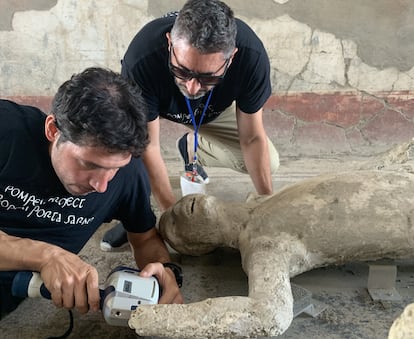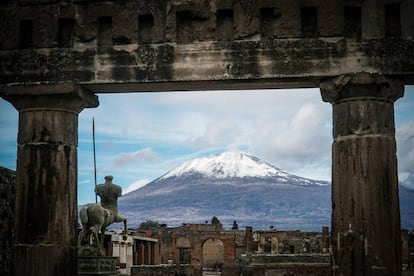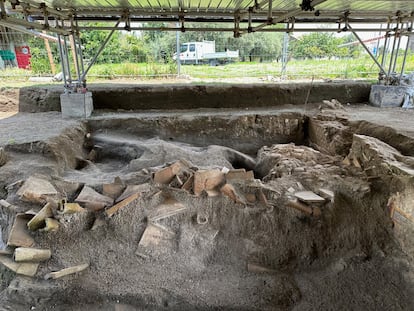Residents of Pompeii who fled the eruption of Vesuvius died of asphyxiation
In a new study, scientists from the University of Valencia analyzed the bones of the volcano’s victims to reconstruct the ancient disaster

The ruins of Pompeii are an extraordinary record of antiquity, illuminating previously unknown details about daily life two millennia ago, while also posing many unanswered questions. For example, and above all: what happened on the day of that historic catastrophe, when the city was annihilated and frozen in time? These and other questions are now finally being answered, with the help of non-invasive scientific techniques and investigative methods that have allowed researchers to travel back in time, without altering the preserved remains, to that fateful autumn day in 79 A.D. when Vesuvius came to life and roared with fury.
For experts, one of the most pressing questions about that day has always been: What exactly caused the people of Pompeii — petrified in time under tons of volcanic material, preserved in the excruciating forms of their agony — to die?
Once their bodies decayed and only skeletons remained, the victims left imprints in the petrified ash, which archaeologists later filled with plaster to obtain molds. This allowed researchers to reproduce, at true scale, the exact positions of the residents at the moment of their deaths, and in turn, to present a realistic rendering of the tragedy and its victims.
Now, a team of researchers under the direction of the University of Valencia, in Spain, has used non-invasive methods involving X-rays and chemical analysis to study the bones of these fossilized victims for the first time. Based on this analysis, researchers have concluded that many residents of Pompeii died of asphyxiation, and not from burns or dehydration, as other theories have posited.
Speaking to EL PAÍS, research team coordinator Gianni Gallello clarified, however, that the study only analyzed a select group of victims, and that the population was destroyed in different ways depending on where individuals were located in relation to the volcano. The inhabitants of Herculaneum, a city closer to Vesuvius that was also annihilated in the eruption, were most likely burned to death by the volcano’s 500 °C pyroclastic flows.
At Pompeii, researchers from the University of Valencia, in collaboration with the University of Cambridge and the Italian Ministry of Culture, have analyzed the remains of six people who fled from the Porta Nola area, and one found near a building known as the Suburban Baths. These victims, researchers concluded, most likely died from the inhalation of toxic volcanic gases as they attempted to flee. After collapsing and succumbing to asphyxiation, their lifeless bodies were quickly covered with ash and other volcanic material. Several victims were found under a three-meter layer of lapilli — small pyroclastic particles — and other debris from the collapse of the buildings.
In addition to the analysis of the bones, the position of the bodies — lying down and stretched out — also confirms the researchers’ theory. Additionally, some victims were found covered with pieces of cloth or clothing, indicating that temperatures were not high enough to incinerate them.
Scientists explain that residents attempted to flee the city during and after the lapilli rain had blanketed the ground with a kind of black hail — small, solid fragments of lava. This lapilli surface would have made walking extremely difficult, which explains why some victims made improvised canes out of tree branches, to help them move faster. After a period of deceptive calm, and already exhausted, the fleeing residents were killed by the second phase of the eruption, which lasted several minutes and produced a toxic cloud that covered Pompeii and left an unbreathable concentration of ash and volcanic gases in the surrounding air. Researchers estimate that these individuals died roughly 20 hours after the first eruption.
Gallello explains that the extreme heat from the pyroclastic waves and magma flows arrived after the victims had already died. The analysis of the bones reveals that the bodies had suffered the consequences of the high temperatures postmortem, with an effect similar to that of cremation.
The research project began in 2019, with the separating out of bones that had not been contaminated by the lime used to make casts of victims. Scientists then analyzed the skeletal remains for information on the thermal impact they had suffered, in an attempt to ascertain whether the extreme heat had affected them during or after their deaths. To do this, researchers compared the Pompeii samples with other data on burned bones from the same period, collected from the Via Ostiense necropolis in Rome and from another necropolis in Valencia, Spain. “The bones from the uncontaminated casts showed similar characteristics to the cremated remains in the rituals of ancient Rome,” Gallello notes.

This week, Gallego published a detailed article on his team’s research in the journal PLoS, co-authored by his colleague at the University of Valencia, Llorenç Alapont, and other researchers from various institutions.
Gallego emphasizes that his team’s project is the first to analyze the skeletons inside the plaster casts at Pompeii — figures that the researcher calls “photocopies of the moment of death” — using this innovative and non-invasive technique. The scientists combined chemical analysis with X-ray fluorescence analysis, in addition to anthropological and taphonomic methods (the study of decay and fossilization). “This research fits all of the pieces of the puzzle together, and provides information that cannot be seen with the naked eye,” Gallello says, adding that his team’s study has also created a low-cost protocol that opens the door to investigating other human remains from different parts of the cities devastated by the volcano, to see if the pattern his team has discovered changes or is repeated, and why.
Gallego emphasizes Pompeii’s value for science. “Life stopped with that catastrophic episode of unprecedented magnitude, and was immortalized there. We are not dealing with a chronology that lasts for years, as we are at other sites; in Pompeii, we see something very concrete: what happened in people’s lives in the matter of just a few hours,” he says. “It is a past kept intact in the present.”
Sign up for our weekly newsletter to get more English-language news coverage from EL PAÍS USA Edition
Tu suscripción se está usando en otro dispositivo
¿Quieres añadir otro usuario a tu suscripción?
Si continúas leyendo en este dispositivo, no se podrá leer en el otro.
FlechaTu suscripción se está usando en otro dispositivo y solo puedes acceder a EL PAÍS desde un dispositivo a la vez.
Si quieres compartir tu cuenta, cambia tu suscripción a la modalidad Premium, así podrás añadir otro usuario. Cada uno accederá con su propia cuenta de email, lo que os permitirá personalizar vuestra experiencia en EL PAÍS.
¿Tienes una suscripción de empresa? Accede aquí para contratar más cuentas.
En el caso de no saber quién está usando tu cuenta, te recomendamos cambiar tu contraseña aquí.
Si decides continuar compartiendo tu cuenta, este mensaje se mostrará en tu dispositivo y en el de la otra persona que está usando tu cuenta de forma indefinida, afectando a tu experiencia de lectura. Puedes consultar aquí los términos y condiciones de la suscripción digital.
More information
Archived In
Últimas noticias
Welcome to the post-religion era: The idea of Christianity as the absolute truth has become obsolete
‘I thought you would like it’: The risky sexual practice popularized by TV shows and TikTok
The digitalization of tourism: ‘They promise experiences and gave us the worst possible one’
Mexican peso defies uncertainty with forecasts of a new period of stability in 2026
Most viewed
- Sinaloa Cartel war is taking its toll on Los Chapitos
- Reinhard Genzel, Nobel laureate in physics: ‘One-minute videos will never give you the truth’
- Oona Chaplin: ‘I told James Cameron that I was living in a treehouse and starting a permaculture project with a friend’
- Why the price of coffee has skyrocketed: from Brazilian plantations to specialty coffee houses
- Silver prices are going crazy: This is what’s fueling the rally











































